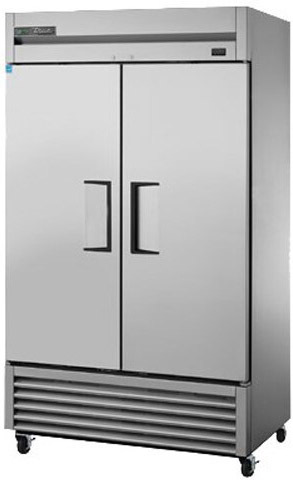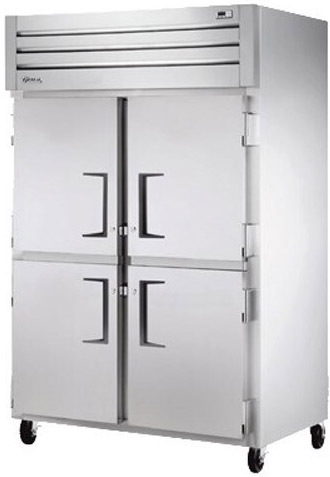Commercial refrigerators and freezers are perhaps the most important pieces of equipment found in restaurant kitchens. But with so many unique models to choose from, picking the option that’s best for your particular foodservice can be a painstaking task. Among the many choices to make is deciding whether you prefer a top-mount or bottom-mount compressor on your commercial cooler. Our catalog contains a large selection of both, and this guide will help you identify whether a top- or bottom-mounted compressor is right for you.
Bottom-mount Refrigerators and Freezers
Ideal for: Hot kitchens and busy cooking lines.
Advantages:

Bottom-mount compressors are situated close to the floor–where ambient air temperature can be as low as 15 degrees cooler than the temperature at the top of refrigerator. This lower air temperature enables bottom-mount condensers to operate more efficiently.
Easy access to the bottom-mount compressor ensures simple cleaning, servicing, and maintenance of the unit. With these types of compressors, you won’t need step ladders to reach the compressor or teams of technicians to take your cooler apart.
Since the compressor is located so close to the floor, it will not be affected by the grease-laden steam and vapor emitted by commercial cooking equipment like fryers. By avoiding exposure to these harmful gases, your commercial cooler’s compressor will work more efficiently and require less maintenance.
A bottom-mounted compressor raises the bottom storage area of your refrigerator or freezer. This means your staff members won’t have to bend over and potentially strain their backs when retrieving items from the bottom of your freezer or refrigerator.
Disadvantages:
Since the compressor is located so close to the floor, unwanted debris like dust, dirt, and spilled ingredients can easily get into the condenser’s coils and cause issues. By consistently cleaning your refrigerator or freezer’s coils once per month, you can help reduce electrical costs and prevent significant system failures.
Lines required to transport refrigerant through freezers and refrigerators occupy a small amount of storage space within the units.
As result of requiring more insulation, longer refrigerant transportation lines, and a larger motor, bottom-mount compressors are more costly to manufacture.
Since heat rises, the heat generated by a bottom-mounted compressor can drift into the storage section of your freezer or refrigerator and make the cooling system less efficient.
Top-mount Refrigerators and Freezers
Ideal for: Locations whose floors are dusty, dirty, or contain dry ingredients that have been spilled.
Advantages:

The unit’s condenser will not be affected by dust, debris, and dry ingredients that have accumulated on the floor.
Operates more efficiently since heat rises from the condenser and does not affect the unit’s storage area.
Refrigerant lines in top-mount units don’t occupy space in the storage area. Instead, they lead directly to the condenser, compressor, and evaporator at the top of the commercial freezer or refrigerator. This means the refrigerant lines are more easily accessed for service and maintenance.
Refrigerators with top-mount compressors have lower shelves, enabling shorter staff members to access every item within the unit. Unlike bottom-mount commercial coolers that feature extra insulation atop their compressors and sacrifice storage space, top mount units boast maximum storage for food and ingredients.
Disadvantages:
Top-mount commercial refrigeration equipment has a tendency to absorb fat-laden grease, which can clog coils and shorten the life of your fridge. As a result, top-mount units are not preferred for cooking lines.
Located at the top of a freezer or refrigerator, top-mount compressors are exposed to hotter ambient air than bottom-mount units. This means top-mount compressors must work harder and are consequently less efficient.
Top-mount compressors may require step ladders to be thoroughly cleaned. Since some service or maintenance requires part of the cooler to be removed, the job can quite be costly–requiring multiple technicians and sometimes special equipment.
Making the Choice
All the information in this guide should be taken into account when deciding what type of compressor is right for your foodservice. But since every kitchen is different, a certain type of compressor might work well for someone else but be a less than ideal fit for your operation. Consequently, make sure to choose commercial refrigeration equipment based on how it efficiently it will perform in your specific restaurant.
